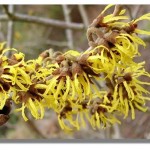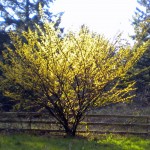We are all ready for spring’s welcoming invitations and as winter subsides and we begin the transition to spring, the gardener in us yearns to get outside into the garden. We find all of the bulbs we  planted last fall, and see what plants are poking up through the ground. We want to clean up the garden, inspect what flower buds are swelling, and hopefully get an early jump to a new gardening season.
planted last fall, and see what plants are poking up through the ground. We want to clean up the garden, inspect what flower buds are swelling, and hopefully get an early jump to a new gardening season.
Most of us wait in great anticipation for the first narcissus or tulip to bloom, and hold our breath until that grand Magnolia finally bursts to life as the lawn takes on its emerald green color. These awesome rights of spring are certainly exciting, but our gardens are often devoid of a handful of early blooming, woody shrubs.
 Forsythia is common to most people and is recognized as the one shrub providing the first true introduction to spring. Forsythia, although one of the earlier bloomers to the spring landscape, is actually later to arrive on the scene when compared to other early blooming shrubs such as Hamamelis (witchhazel), Corylopsis (fragrant winterhazel), and Cornus mas (Corneliancherry dogwood).
Forsythia is common to most people and is recognized as the one shrub providing the first true introduction to spring. Forsythia, although one of the earlier bloomers to the spring landscape, is actually later to arrive on the scene when compared to other early blooming shrubs such as Hamamelis (witchhazel), Corylopsis (fragrant winterhazel), and Cornus mas (Corneliancherry dogwood).
These ornamentals, when utilized in the landscape, offer real hope that winter is coming to a close. Hamamelis is the first to appear providing lacy, sulfur/yellow flowers and then wowing us again in the fall with hues of yellow to brilliant orange/bronze foliage. Other cultivars of witchhazels produce red to orange flowers and fragrance. Corylopsis follows closely and provides fringy pale, yellow flowers and a nice wide form. Cornus mas is next to grace the landscape with its abundance of bright yellow, button-shaped flowers that absolutely cover the plant. These flowers give way to small cherry shaped fruit enjoyed by both birds and humans and finishes the season with a wonderful exfoliating bark giving great winter interest.
All of these species can be used as specimens in any garden setting, and also lend themselves nicely in a shrub border mixed with other ornamentals and evergreens. They are easy to grow in our native soils and are well worth inclusion in our gardens.
One of my favorite things to do when I am feeling blue in the late winter is to take a stroll through our nursery anticipating a glimpse of one or all of these beauties welcoming me to the new spring season, thus reassuring me that the end of winter is near and inviting me to the outdoors when I otherwise wouldn’t leave the office.
The best news is that Hamamelis has taken the first step already this season, letting me know that winter’s days are numbered. Exciting!
